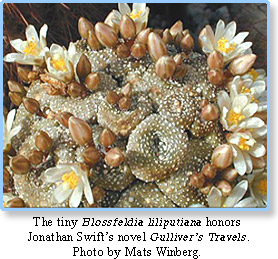Blossfeldia (2016)
 By Eric Driskill (November 2016)
By Eric Driskill (November 2016)
Blossfeldia belongs to the subfamily Cactoideae and tribe Notocacteae. Blossfeldia was discovered in 1936 by Harry Blossfeld and Oreste Marsoner in northern Argentina. The genus was described by Erich Werdermann in 1937, honoring Blossfeld.
Botanically speaking, Blossfeldia is very unique for several reasons. It is the smallest of all known cacti genera for starters, but that’s not where the weirdness ends! Anatomical studies revealed this genus almost entirely lacks stomata and certainly has the fewest stomata per unit of surface area of any photosynthesizing plant.
Blossfeldia plants also lack a thickened cuticle or outer cell wall, which is what allows most other cacti to avoid desiccation. Blossfeldias, in fact, are believed to be poikilohydric, meaning they can endure severe drying out, like many mosses and lichens can. The plants have the ability to lose up to 80 percent of their moisture and still withstand droughts lasting more than a year. They are able to survive almost total loss of moisture and rehydrate their cells when watered again.
The genus has only one species, B. lilliputiana, honoring Jonathan Swift’s novel Gulliver’s Travels. Blossfeldia was discovered in northern Argentina 210 years after Swift’s novel and oddly enough at roughly the same latitude in South America as Lilliput and Blefuscu, the two fictional island nations featured in Swift’s novel.
Blossfeldia plants are found over a wide geographic area from southern Bolivia to northwest Argentina at elevations of 1,200 to 3,600 meters. Blossfeldias are found growing on rocky slopes, often in the cracks of almost vertical shalelike cliffs.
The plants are buttonlike and gray-green without ribs or tubercles. They grow to to 0.5 inches in diameter and have no spines. The plants do have areoles, which spiral around the plant and bear tufts of wool. If you look closely at several plants, you will notice that some tufts spiral one direction, while other plants have tufts that spiral in the other direction.
The flowers are white to pink, 6 to 15 millimeters long and 5 to 7 millimeters in diameter. The plants’ tuberous roots anchor them to their precarious perches on those cliff faces.
Blossfeldias require some shade and a very porous potting mix. Growth is extremely slow, and the plants are often difficult to raise from seed. It may take up to five years for plants to grow large enough to water with anything other than a mister. Some people use the bagging method when germinating seed, and may leave the plants in their bags for up to two years.
Most often, plants for sale are grafted. Grafted plants often form many-headed specimens atop their stocks. The flattened, buttonlike growth gives way to a more globular growth when grafted.
The advantages of grafting include a plant that isn’t nearly as sensitive to root rot and grows much faster. Grafted plants also have many heads to admire. When the heads become globular, the spiraling tufts are more apparent, since there is more surface area to cover.
The plants are often self-fertile and produce seed in abundance, although the seeds are less than 0.5 millimeter long. They often appear to be dust or grit on the plant heads when the seed pods open. Blossfeldia is certainly a plant species you may want to consider adding to your collection – it certainly will never take up much room!
